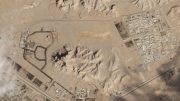Opening with the caveat “Remember, this is relatively new to all of us”, Penn State Extension educator Dan Brockett outlined the basics for a new industry moving into the region during a public forum Wednesday.
The topic for the session, held at the Venango County Fairgrounds, was the relatively new commercial interest in establishing solar panel farms throughout Pennsylvania.
In response to that interest, the extension office and the Pennsylvania Farm Bureau teamed up to hold an informational workshop. A large crowd of property owners attended the session.
Brockett said there are 15 solar farm projects underway in Pennsylvania, and all are “utility-scale solar” projects that are designed for wholesale power generation. They are not “the roof top solar panels’ that are in common use, he said.
Not in the offing yet, either, are community-dedicated solar panel operations, a specialty of Cypress Creek, that have been established in New York.
There are key elements
Experts in solar energy have shared with Brockett that “there’s enough sun everywhere in Pennsylvania” and that, coupled with new technology, a dramatic drop in the cost of solar panels, energy credit trading and a public push for alternative fuel sources have spurred efforts to launch solar farm projects in the state.
“Sites near high transmission lines and substations have seen interest from solar developers in Pennsylvania,” Brockett told his audience.
The key elements being eyed by developers include no shading by buildings or trees, land slope, soil composition, exposure to southerly sun, relatively inexpensive land, valid land titles, intact oil/gas/mineral rights and access within two miles of an electric substation.
The amount of land required for a solar farm varies. An estimated five to eight acres of land devoted to solar panels will yield one MW (megawatt) of electric energy, said Brockett.
Most Pennsylvania projects are expected to use five to eight acres, he said, but many could cover greater acreage depending on the site.
As western Pennsylvania is full of oil and gas wells as a result of its energy heritage, the oil/gas/mineral rights are a vital element in any potential lease signing for solar panel projects, said George Thompson, a Franklin attorney who assisted with Brockett’s presentation this week.
“Subsurface ownership rights are dominant,”said Thompson. “There are tons of leases out there … You need to tell them (leasing agents) everything, every arrangement you have for your land.”
So what’s in a lease?
Professionals known as landmen are inquiring about options and leasing, or renting, land throughout western Pennsylvania, said Brockett. At least a few local landowners have signed leases for solar panel installations.
Lease agreements as well as options to lease hold no promise of immediate development but, instead, reserve the land parcel for possible development.
“Remember, these are developers’ options, not the owner’s option,” said Brockett. “A signed option (to lease) could restrict your property.”
For that reason, a landowner interested in signing an option and eventually leasing property for solar panel installations should get “legal assistance” to sort out a long list of priorities and concerns, said Brockett.
Topics that should be discussed include the length of the lease; costs of engineering/title searches/funding sources; construction phase work that could include grading, access roads and more; panel maintenance and access; path to power lines (buried/trenched or poles or combination); land restoration; vegetation control; length of lease.
Thompson said a developer would most likely take “a five-year option and than a 20-year operational lease … (with) renewals that could stretch out a long time.”
Emphasizing the details that should go into option and lease agreements, Thompson said, “You need help with this. … Remember, if it is not put in the agreement, it is meaningless.”
As to what monetary rewards are in the offing for solar panel project leasing, Brockett said “the economics behind solar development are always changing.”
“I do know this – the dairy industry … wow, at $500 lease an acre? It would unstress a lot of my family and friends,” he said.
According to studies by the farming industry, an option or a lease could produce between $800 and $1,200 per acre annually. In this region, said Brockett, a typical solar panel lot might be five acres.
“I’ve seen fliers here asking for a minimum of 150 acres to option … but they probably won’t use it all,”said Brockett.
In emphasizing the need for property owners to consult with professionals such as attorneys and accountants before signing options or leases, Brockett said, “There are really no experts around to answer all these questions because we just haven’t seen it. But, you need to take everything into consideration.”
Brockett said the Penn State Extension Office is preparing information available to the public on solar panel projects.










































